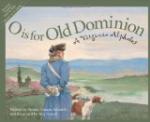However, there was enough taking place on our own side of the island. We had no sooner got the isthmus up out of the water than figures began to move across it. But such figures! Was there a mistake somewhere? These were not Englishmen, and they were not Indians. Behold, crossing our isthmus, Dutchmen, Italians, and Poles! Suddenly, from the midst of the group, came a glint and a flash of blue. Then we understood. These were the “skilful workmen from foreign parts” early sent over to the colony to make glass beads, preferably blue ones, for barter with the Indians.
Now, there were only two people on our isthmus—an Indian and a red-headed man. The Indian was tall and “a most strong stout Salvage”; the red-headed man was short but a most strong, stout Englishman. The Indian was Wowinchopunk, chief of the Paspaheghs; the red-headed man was Captain John Smith. A desperate hand-to-hand struggle ensued. We remembered that fight in the school-books, but we had never expected to really see it. Our sympathies were of course largely with the Captain, but more with the isthmus. We had raised it out of the water for temporary purposes only, and with no idea of its being subjected to a strain like this. It was a relief when the two fighters rolled off into the water. By the time they had struggled out again, the white man was victor. As dripping captor and captive set off toward James Towne, we saw Fame stick another laurel leaf in the wet, red hair in commemoration of the single combat in which Captain John Smith defeated the “strong, stout Salvage,” Wowinchopunk, on the James Towne isthmus.
For a while after that, nothing much happened over our way. Indians occasionally passed and repassed; now striding openly across to the island on friendly visit, now skulking over to pick off unwary settlers. Once we caught, in a hazy way, the most touching picture associated with the old isthmus—the little savage maiden, Pocahontas, with heart divided between her own people and the pale-faces, crossing over at the head of her train of Indians bearing venison and corn for the half-famished settlers. Pathetic little figure! Often all that seemed to stand between the colonists and destruction.
It was the sound of voices that now made us turn and look the other way. Many people were following the crook in our road, passing through the bit of woodland and coming out at “Friggett Landing.” We had heard no “musical note,” but evidently the townspeople had; and there, surely enough, was a queer little vessel stopping right where we had marked the spot. It was a pleasure to see that she so readily took our measurements for it. But how she got there perplexed us not a little, as we remembered the row of pilings across the stream that had stopped the houseboat, and which, even in our ardour to restore the colonial setting, we had not once thought to remove.




